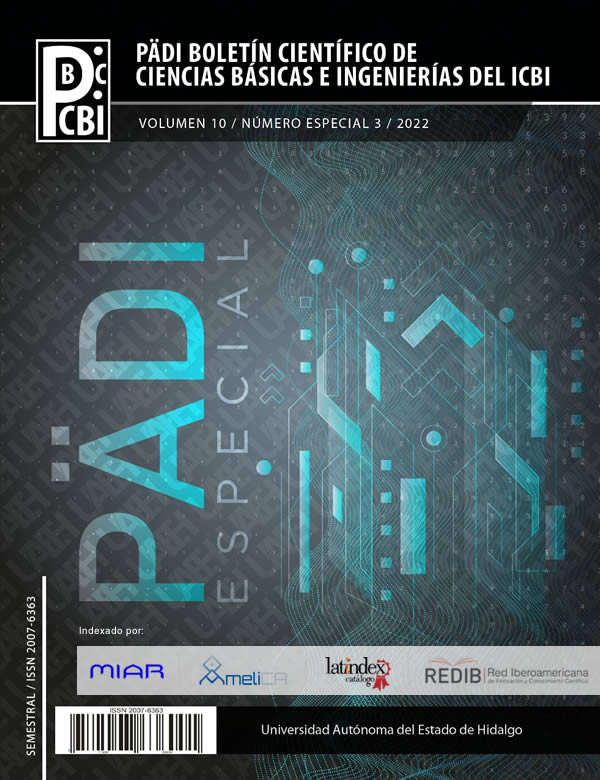Sistema IoT y validación estadística para monitoreo de salud de estudiantes
DOI:
https://doi.org/10.29057/icbi.v10iEspecial3.9004Palabras clave:
Internet de las cosas, normalidad, varianza, sensores, sobrepesoResumen
La combinación del Internet de las Cosas y de la Estadística para Ciencias de los Datos resulta bastante interesante, sobre todo cuando se aplican dentro del área educativa. Este trabajo propone el desarrollo de una estación de salud (kiosko) y del análisis de los datos biométricos obtenidos a través de un procedimiento experimental con el cual obtener valores de variables antropométricas que sean útiles para indicar el estado de salud de estudiantes de la Preparatoria 2, perteneciente a la Universidad Autónoma del Estado de Hidalgo. En una primera fase, el trabajo propone la medición de peso y estatura de las y los estudiantes, así como el Índice de Masa Corporal, el cual se emplea tradicionalmente para determinar sobrepeso y su relación con otros tipos de enfermedades. Los resultados experimentales muestran que adquirir esta información requiere de sensores de peso y estatura, para cuyo análisis estadístico existen modelos que permiten realizar pruebas de normalidad y homogeneidad de varianzas, las cuales resultan útiles para determinar el tipo de estadística a usar.
Descargas
Información de Publicación
Perfiles de revisores N/D
Declaraciones del autor
Indexado en
- Sociedad académica
- N/D
Citas
Aishah, N., Yin, T. S., Othman, A. R., and Yaacob, C. R. (2011). Sensitivity of Normality Tests to Non–normal Data (Kepekaan Ujian Kenormalan Terhadap Data Tidak Normal). Sains Malay- siana, 40(6):637–641.
Ali, S. M. and Nihad, M. (May 2021). Internet of Things for Educa- tion Field. Journal of Physics: Conference Series, 1897(1):1–9.
Amaraweera, S. P. and Halgamuge, M. N. (2019). Internet of Things in the Healthcare Sector: Overview of Security and Privacy Issues. In Mahmood, Z., editor, Security, Privacy and Trust in the IoT Environment, chapter 8, pages 153 – 179. Springer.
Brown, S. (2008 – 2022). Measures of shape: Skewness and kurtosis. https://brownmath.com/stat/shape.htm
Brownlee, J. (2020). Continuous Probability Distributions. In Pro- bability for Machine Learning: Discover How To Harness Uncer- tainty with Python, chapter 9, pages 60–72. Machine Learning Mastery Books.
Doane, D. P. and Seward, L. E. (2011). Measuring skewness: A for- gotten statistic? Journal of Statistics Education, 19(2):18 pages. Hain, J. (2010). Chapter 3 Moment Tests for Normality. PhD thesis, In Comparison of Common Tests for Normality, Thesis at Julius– Maximilians–Universität Würzburg, Institut für Mathematik und Informatik, Lehrstuhl für Mathematik VIII (Statistik).
Jambu, M. (1991). 1–D Statistical Data Analysis. In Exploratory and Multivariate Data Analysis, chapter 3, pages 27–62. Acade- mic Press.
Joanes, D. N. and Gill, C. A. (1998). Comparing measures of sample skewness and kurtosis. Journal of the Royal Statistical Society. Series D (The Statistician), 47(1):183–189, 7 pages.
Juárez, E. A. O., Ávila Wall, L., and Acosta, L. R. S. (2014). Causas de Inasistencia a Clases de los Estudiantes– Caso: Estudiantes de la FCA de la UACH. In Memorias en extenso XV Congreso Asociación de Profesores de Contaduría y Administración de México (APCAM), page 19. Asociación de Profesores de Contaduría y Administración de México. http://www.fca.uach.mx/ apcam/2014/04/05/Ponencia%20111-UACH.pdf.
Kim, H.-Y. (February 26, 2013). Statistical notes for clinical resear- chers: assessing normal distribution (2) using skewness and kur- tosis. Restorative Dentistry & Endodontics, 38(1):52–54. https:
//www.ncbi.nlm.nih.gov/pmc/articles/PMC3591587/
Kim, R., Pathak, P. K., Tripathi, N., and Subramanian, S. V. (2020). Heterogeneity in adult anthropometry by socioeconomic factors: Indian National Family Health Survey 2006 and 2016. European Journal of Clinical Nutrition, 74:953 – 960.
Mara, C. and Cribbie, R. A. (2018). Equivalence of Population Va- riances: Synchronizing the Objective and Analysis. The Journal of Experimental Education, 86(3):442 – 457.
NIST (2022). 1. Exploratory Data Analysis/1.3. EDA Techni- ques/1.3.5. Quantitative Techniques/1.3.5.11. Measures of Skew- ness and Kurtosis. In Engineering Statistics Handbook, NIST/SEMATECH e-Handbook of Statistical Methods, chapter 1. http://www.itl.nist.gov/div898/handbook/.
Rayan, R. A., Tsagkaris, C., and Iryna, R. B. (2021). The Internet of Things for Healthcare: Applications, Selected Cases and Cha- llenges. In IoT in Healthcare and Ambient Assisted Living, pages 1–15. Springer.
Trivedi, M. (2017). Skewness and Kurtosis. Post–Graduate Di- ploma in Applied Statistics (PGDAST) community home page, MST – 002 Descriptive Statistics. In Block–1 Analysis of Quan- titative Data, chapter 4. eGyankosh– a National Digital Repo- sitory, India, Indira Gandhi National Open University.




















